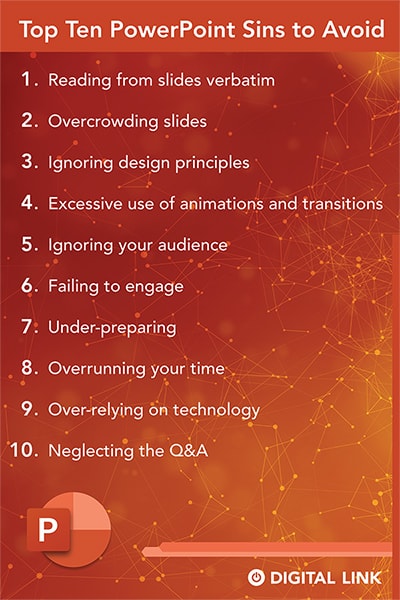
Grab your clickers and sit back, we’re venturing into the thrilling world of PowerPoint presentations! Though often associated with tedious meetings and classroom snooze-fests, these handy slides can also be tools of greatness. To help you out, we’re unveiling the top 10 secrets to making PowerPoint better, along with 10 unforgivable sins you’d best avoid.
First, let’s start at the very beginning. Afterall, it’s a very good place to start…
PowerPoint, in a Nutshell
Ah, PowerPoint! Our trusty companion through countless presentations. This useful piece of software from Microsoft allows users to create captivating visual aids that share ideas, data, or simply guide the audience through a narrative. Boasting features like images, text, animations, and multimedia, PowerPoint empowers presenters to design tailor-made presentations that resonate with their audiences.
When to Use PowerPoint
PowerPoint shines in a multitude of scenarios, be it a business conference, classroom lecture, or workshop. It works like a charm when:
- Breaking down intricate concepts into digestible visuals, such as charts or diagrams.
- Presenting data through graphs, making it more palatable and insightful.
- Conveying a clear narrative or sequence of ideas.
- Engaging audiences with multimedia elements, like videos, audio clips, or interactive quizzes.
- Reinforcing key messages, guiding the audience, and boosting information retention.

The Tale of PowerPoint
PowerPoint’s story begins in 1984 when former Apple employee Robert Gaskins envisioned a presentation software at a startup called Forethought. Alongside software developer Dennis Austin, Gaskins created “Presenter” for Macintosh computers.
Microsoft swooped in, acquiring Forethought and its ground-breaking software in 1987, rebranding it as “PowerPoint.” Initially a simple tool for generating overhead transparencies, PowerPoint evolved as personal computers became increasingly popular. New features and capabilities were added, catering to users’ ever-changing needs and technological advancements.
Fast forward to today, and PowerPoint is a presentation powerhouse, used by millions worldwide across diverse industries. Its adaptability and continuous innovation have solidified its place as a go-to software for presenters, empowering them to communicate their ideas with flair and finesse.
The theoretical maximum number of slides is 2,147,483,648. If you ever get close, please note that your presentation is too long!
DID YOU KNOW?
The Future Beckons
PowerPoint’s journey is far from over. As we peer into the future, we can expect the software to continue adapting to cutting-edge technologies and users’ needs. Some exciting developments we might encounter include:
- AI-driven features that make designing presentations a breeze, offering suggestions for layouts, content, and designs tailored to the presenter’s style and goals.
- VR and AR technologies to craft immersive experiences, letting the audience explore 3D models or visualize data like never before.
- Collaborative tools that enable teams to work in real-time on presentations, regardless of location – perfect for remote work and virtual meetings.
- Compatibility with a range of devices and platforms, ensuring users have a seamless experience on any device.
- Real-time audience interaction, allowing presenters to gauge reactions, address questions, and adapt their delivery to keep viewers engaged.
- Voice-assistant integration to make navigating slides and accessing relevant information a hands-free affair.
- Copilot. Integration with AI like GPT-4 was inevitable and is coming to fruition sooner rather than later. Ask for features like transitions or changing images in real time using conversational language.

Top Ten Tips for a Powerful PowerPoint Presentation
Keep it simple, smarty (KISS):
Less is more. Overloading slides with information creates visual clutter and distracts your audience. Stick to essential points, utilizing concise text and clean design elements. Remember, you’re the star, not the slides.
Prioritize legibility:
Choose fonts that are easy to read, such as Arial, Calibri, or Helvetica. Avoid decorative or overly stylized options. Ensure text size remains large enough for those in the back row to decipher. Contrast between background and text colors should be sharp, facilitating effortless readability.
Images speak louder than words:
Visual aids bolster comprehension and retention. Ditch lengthy bullet points in favor of impactful, relevant graphics. High-quality photos, graphs, and diagrams will engage viewers and support your message. Bonus points for originality and humor.
Embrace consistency:
Adhere to a uniform theme, color scheme, and font choice throughout your presentation. Consistency contributes to a polished, professional appearance, helping to maintain focus on your content. Avoid overuse of animations, transitions, and sound effects, which can detract from your message.
Pace yourself:
Structure your presentation with clear, logical flow. Divide content into digestible sections, guiding your audience through a natural progression of ideas. Allow time for questions or discussion between sections and rehearse timings to prevent rushing or dragging.
Nail those numbers:
Data can provide compelling evidence to support your argument. However, ensure charts and graphs are visually digestible, highlighting critical information without overwhelming viewers. Simplify complex statistics and consider using animations to reveal data sequentially, allowing time for comprehension.
Tell a story:
Craft a narrative around your content, connecting with the audience on an emotional level. Relatable anecdotes and real-life examples bring your message to life, fostering engagement and memorability. Be authentic and passionate, inviting your audience to join you on the journey.
Make it interactive:
Engage viewers by incorporating interactive elements such as polls, quizzes, or group activities. Encourage questions and discussion, fostering a dynamic, collaborative atmosphere. Active participation enhances learning and helps maintain audience attention.
Prepare for technical hiccups:
Always have a backup plan in case technology fails. Save your presentation on multiple devices and consider printing handouts. Familiarize yourself with the venue’s equipment beforehand, and practice setting up and troubleshooting common issues.
Rehearse, rehearse, rehearse:
Practice makes perfect. Rehearse your presentation multiple times, refining your delivery and honing your content. Time yourself, ensuring you stay within allocated limits. Consider soliciting feedback from trusted friends or colleagues to polish your performance.

Top Ten PowerPoint Sins to Avoid
Reading from slides verbatim:
Your audience can read. Regurgitating slide content verbatim is boring and redundant. Use the slides as prompts, elaborating on key points with additional insights or anecdotes.
Overcrowding slides:
Resist the temptation to cram too much information onto a single slide. Cluttered slides confuse and overwhelm viewers, detracting from your message. Remember KISS: Keep it simple, smarty. Remember the 7 x 7 rule if you must include any volume of text. (7 lines with no more than 7 words per line)
Ignoring design principles:
Poor design choices, such as inconsistent formatting, clashing colors, or tiny fonts, can make your presentation appear unprofessional. Prioritize legibility, consistency, and visual appeal.
Excessive use of animations and transitions:
While they can add visual interest, overdoing animations and transitions distracts from your message. Use these features sparingly, ensuring they enhance rather than detract from your content.
Ignoring your audience:
Remember, you’re presenting to real people. Gauge their reactions and adjust your delivery accordingly. If they seem confused or disinterested, slow down, clarify points, or engage them with questions.
Failing to engage:
Monotone delivery, lack of eye contact, and minimal interaction can bore viewers. Strive for a dynamic, engaging presentation style, incorporating humor, passion, and audience participation.
Under-preparing:
Winging it rarely works. Unprepared presenters risk stumbling over words, losing their train of thought, or failing to cover essential points. Rehearse your presentation thoroughly to ensure a polished performance.
Overrunning your time:
Respect your audience’s time and attention by sticking to allocated limits. Rambling on or rushing through slides can frustrate viewers and harm your credibility. Rehearse timings and adjust content as necessary.
Over-relying on technology:
Though PowerPoint can enhance your presentation, it shouldn’t be the sole focus. You are the star. Ensure your content and delivery shine, even if technical issues arise.
Neglecting the Q&A:
Anticipate questions your audience may ask and prepare thoughtful responses. Engage with questioners and be willing to admit when you don’t know the answer. Fostering a collaborative, open atmosphere demonstrates respect and encourages dialogue.
PowerPoint presentations can either delight or dismay. By sticking to our top ten tips and avoiding the cardinal sins, you’ll be well on your way to mastering the art of presenting. Remember, simplicity, clarity, and audience engagement are the keys to a successful PowerPoint. Now, go forth and conquer those presentations with confidence!
Liked this article?
We are adding more useful articles to our blog every week! Join our subscribers to stay up to date on digital security, marketing, and social media trends.
By entering your email, you agree to receive our monthly newsletter. You can unsubscribe at any time!


